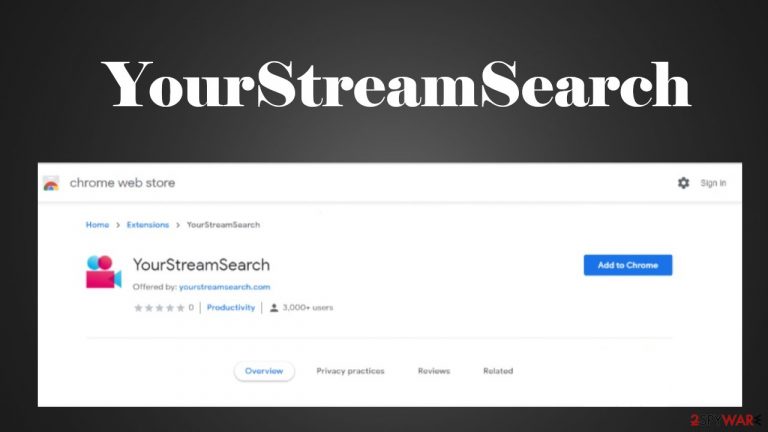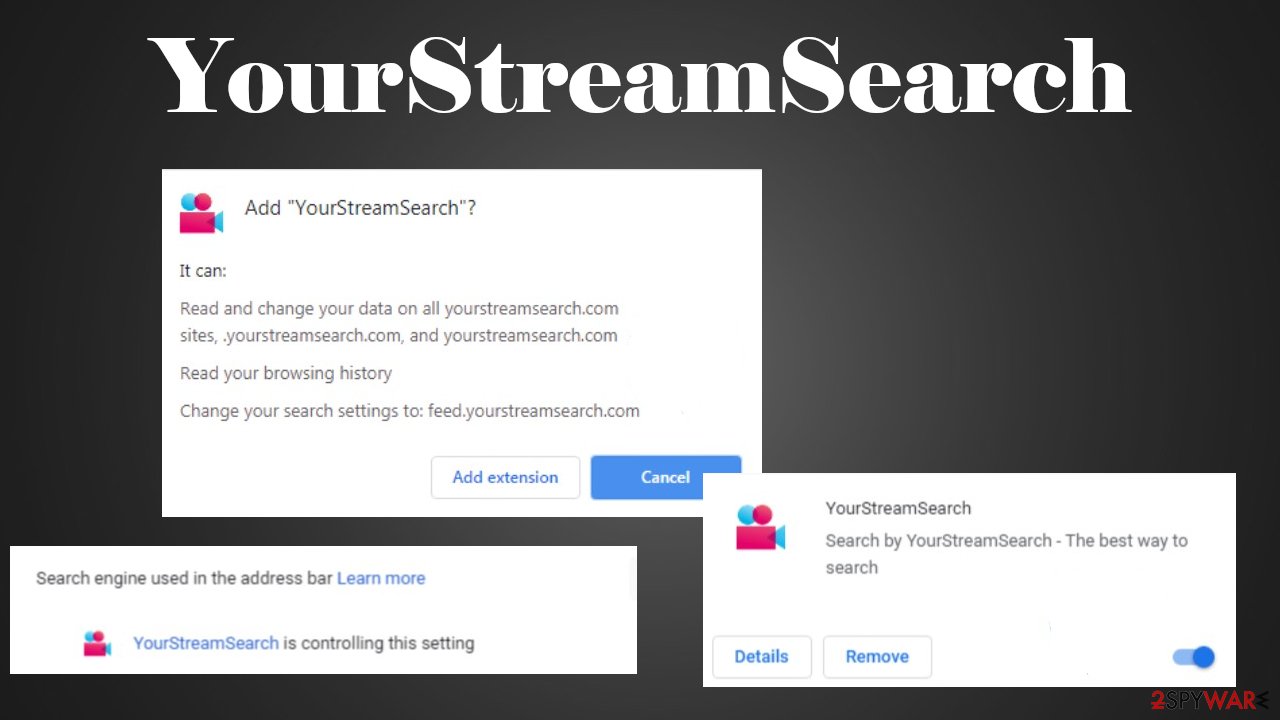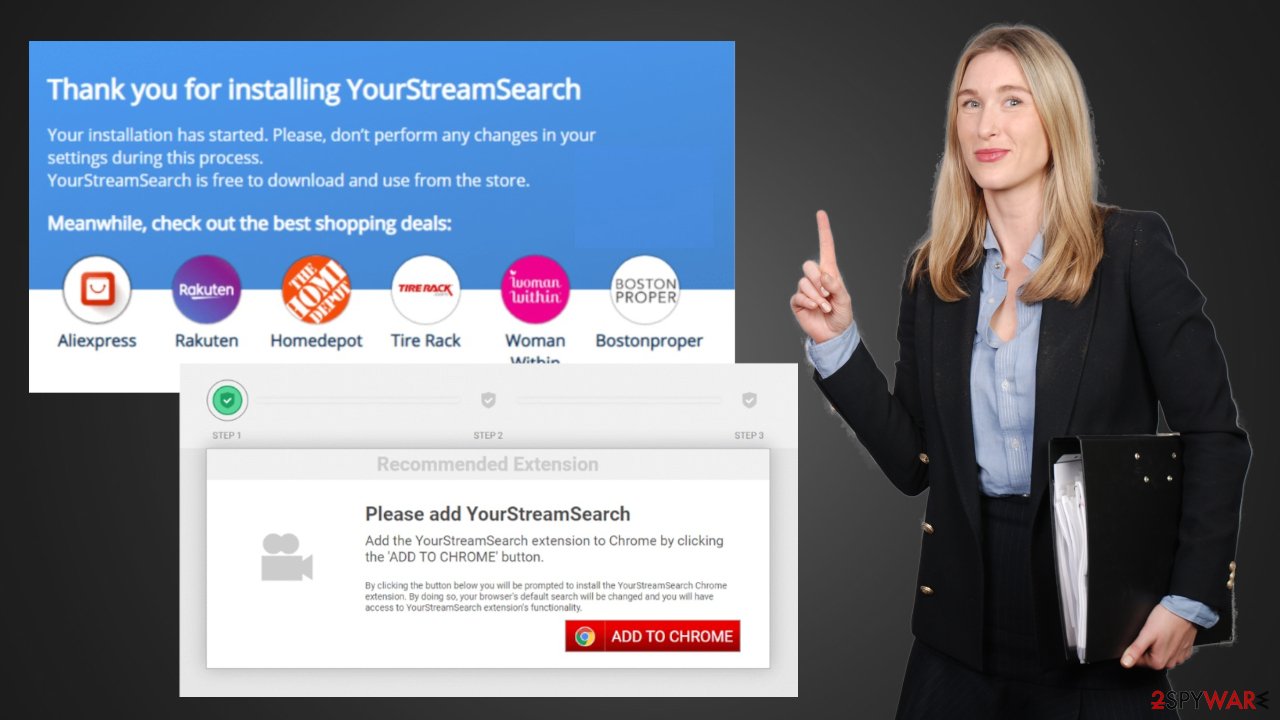YourStreamSearch (Virus Removal Instructions)
YourStreamSearch Removal Guide
What is YourStreamSearch?
YourStreamSearch – a browser hijacker that modifies settings without your direct consent

YourStreamSearch is a potentially unwanted program that can affect Windows and Mac devices. When it's in the system, it changes the default search engine, homepage, and new tab preferences on your browser. By doing so, this browser hijacker can redirect all search inquiries through a fake search engine in feed.yourstreamsearch.com.
Search results are shown from either Yahoo, Bing, or another legitimate provider but with a slight alteration – advertisements. They are shown as search recommendations and might even be displayed as notifications. These ads could lead to dangerous portals, so you should refrain from clicking on any of them.
One more concern about YourStreamSearch browser hijacker is that it is also capable of collecting browsing-related data. Thus you shouldn't install it and if you did, remove it. By reading this article, you'll find out how to do that and how to restore your device to a pre-contamination phase.
| name | YourStreamSearch |
|---|---|
| Type | Browser hijacker, redirect virus, PUP |
| Altered browser settings | Homepage, new tab, default search engine |
| appointed fake search site | feed.yourstreamsearch.com |
| IP address | 172.67.180.212 |
| Symptoms | Search inquiries are going through unknown pages; search results are shown from a different provider; new tabs with questionable content open out of nowhere |
| risks | Installation of additional PUPs, malware infections, privacy issues |
| Distribution | Deceptive ads, official marketplaces, fake Flash Player updates, software bundles |
| Elimination | You can remove this PUP with a proper anti-malware tool and then use our guides below to restore browser settings or reset them |
| System repair | Browser hijackers modify not only browser settings but system files and settings too. That's why you should use the FortectIntego system diagnostics tool to resolve all system-related irregularities |
Although some of you may think that having a couple of browser settings altered isn't a big deal, let us explain why these cyber threats are dangerous. First of all, by making these alterations, YourStreamSearch browser enables itself to gather browsing and device details, including:
- used apps,
- search inquiries,
- addresses of visited pages,
- IP addresses and geolocations,
- device and browser info, etc.
Normally, such information is used by advertisers to customize ads specifically for you to make them irresistible to click. But there's no guarantee that such details won't be shared with third parties who can have ill intentions and misuse them for their own goals.
YourStreamSearch virus is also capable of showing you deceptive ads. They can be seen as search recommendations but could also be shown as notifications, directly computer desktop. These ads are deceptive as an ad for a breaking news story could redirect you to any of the PUPs affiliated sites.
Furthermore, this browser-based infection can cause sudden redirects on demand. Then you will be forced to visit a site of its choice. The main risks are not in the browser itself but in its affiliated sites, which could try to lure you into gambling, draw out personal details, infect devices with malware instantly through drive-by downloads, and so on.

That's why such infections are dangerous, and we urge our readers to remove YourStreamSearch browser hijacker from all devices immediately. To make sure it's properly eliminated, you should run a full system scan with Malwarebytes, SpyHunter 5Combo Cleaner, or similar trustworthy anti-malware software. Then check if it's not hiding in your browser extensions.
If you're not 100% sure how to do that, use our guides posted at the bottom of the article and remove the extension. Once all that is done, all is left to repair the damage your device's system sustained from this infection. Cybersecurity experts [1] highly recommend performing a system tune-up with the FortectIntego system diagnostics tool.
Uninstall the Flash Player and don't download its updates to avoid PUPs and malware
Adobe has announced that from December 31, 2020, it is discontinuing support for Flash Player. The company also urged users to uninstall this software for security purposes. But many people are unaware of this, and cybercriminals exploit that by suggesting fake Flash Player updates.
These are usually encountered on high-risk or hacked websites. They can come in various forms and colors, but all of them contain either potentially unwanted programs, such as adware, browser hijackers, or severe malware infections like Trojans,[2] ransomware,[3] etc.

Thus if you ever see a pop-up suggesting that you need to update or install Flash Player on your device, please remember that it's fake and can cause a lot of trouble. Close the tab or the whole browser, run a system tune-up that deletes all tracking cookies and your browsing history.
Remove YourStreamSearch virus and restore browser settings with ease
Browser hijackers can be installed either as browser extensions or as applications. Whichever it might be, we highly recommend scanning your device with a reliable anti-malware tool to remove any suspicious, untrustworthy, or malicious files/apps/entries.
A reliable security tool is a must these days, as cybercrime is on the rise and threat actors aren't slowing down any time soon. If you had dependable AV software, it would have prevented you from installing YourStreamSearch as it would have identified it as a PUP.
Once you finish the scan, use our comprehensive guides below to check if YourStreamSearch isn't installed as a browser extension. If it is, remove it ASAP. Then restore your browser settings, perform system diagnostics with compatible tools to resolve any system-related issues, and you're all set.
You may remove virus damage with a help of FortectIntego. SpyHunter 5Combo Cleaner and Malwarebytes are recommended to detect potentially unwanted programs and viruses with all their files and registry entries that are related to them.
Getting rid of YourStreamSearch. Follow these steps
Uninstall from Windows
Instructions for Windows 10/8 machines:
- Enter Control Panel into Windows search box and hit Enter or click on the search result.
- Under Programs, select Uninstall a program.

- From the list, find the entry of the suspicious program.
- Right-click on the application and select Uninstall.
- If User Account Control shows up, click Yes.
- Wait till uninstallation process is complete and click OK.

If you are Windows 7/XP user, proceed with the following instructions:
- Click on Windows Start > Control Panel located on the right pane (if you are Windows XP user, click on Add/Remove Programs).
- In Control Panel, select Programs > Uninstall a program.

- Pick the unwanted application by clicking on it once.
- At the top, click Uninstall/Change.
- In the confirmation prompt, pick Yes.
- Click OK once the removal process is finished.
Delete from macOS
Remove items from Applications folder:
- From the menu bar, select Go > Applications.
- In the Applications folder, look for all related entries.
- Click on the app and drag it to Trash (or right-click and pick Move to Trash)

To fully remove an unwanted app, you need to access Application Support, LaunchAgents, and LaunchDaemons folders and delete relevant files:
- Select Go > Go to Folder.
- Enter /Library/Application Support and click Go or press Enter.
- In the Application Support folder, look for any dubious entries and then delete them.
- Now enter /Library/LaunchAgents and /Library/LaunchDaemons folders the same way and terminate all the related .plist files.

Remove from Microsoft Edge
Delete unwanted extensions from MS Edge:
- Select Menu (three horizontal dots at the top-right of the browser window) and pick Extensions.
- From the list, pick the extension and click on the Gear icon.
- Click on Uninstall at the bottom.

Clear cookies and other browser data:
- Click on the Menu (three horizontal dots at the top-right of the browser window) and select Privacy & security.
- Under Clear browsing data, pick Choose what to clear.
- Select everything (apart from passwords, although you might want to include Media licenses as well, if applicable) and click on Clear.

Restore new tab and homepage settings:
- Click the menu icon and choose Settings.
- Then find On startup section.
- Click Disable if you found any suspicious domain.
Reset MS Edge if the above steps did not work:
- Press on Ctrl + Shift + Esc to open Task Manager.
- Click on More details arrow at the bottom of the window.
- Select Details tab.
- Now scroll down and locate every entry with Microsoft Edge name in it. Right-click on each of them and select End Task to stop MS Edge from running.

If this solution failed to help you, you need to use an advanced Edge reset method. Note that you need to backup your data before proceeding.
- Find the following folder on your computer: C:\\Users\\%username%\\AppData\\Local\\Packages\\Microsoft.MicrosoftEdge_8wekyb3d8bbwe.
- Press Ctrl + A on your keyboard to select all folders.
- Right-click on them and pick Delete

- Now right-click on the Start button and pick Windows PowerShell (Admin).
- When the new window opens, copy and paste the following command, and then press Enter:
Get-AppXPackage -AllUsers -Name Microsoft.MicrosoftEdge | Foreach {Add-AppxPackage -DisableDevelopmentMode -Register “$($_.InstallLocation)\\AppXManifest.xml” -Verbose

Instructions for Chromium-based Edge
Delete extensions from MS Edge (Chromium):
- Open Edge and click select Settings > Extensions.
- Delete unwanted extensions by clicking Remove.

Clear cache and site data:
- Click on Menu and go to Settings.
- Select Privacy, search and services.
- Under Clear browsing data, pick Choose what to clear.
- Under Time range, pick All time.
- Select Clear now.

Reset Chromium-based MS Edge:
- Click on Menu and select Settings.
- On the left side, pick Reset settings.
- Select Restore settings to their default values.
- Confirm with Reset.

Remove from Mozilla Firefox (FF)
Remove dangerous extensions:
- Open Mozilla Firefox browser and click on the Menu (three horizontal lines at the top-right of the window).
- Select Add-ons.
- In here, select unwanted plugin and click Remove.

Reset the homepage:
- Click three horizontal lines at the top right corner to open the menu.
- Choose Options.
- Under Home options, enter your preferred site that will open every time you newly open the Mozilla Firefox.
Clear cookies and site data:
- Click Menu and pick Settings.
- Go to Privacy & Security section.
- Scroll down to locate Cookies and Site Data.
- Click on Clear Data…
- Select Cookies and Site Data, as well as Cached Web Content and press Clear.

Reset Mozilla Firefox
If clearing the browser as explained above did not help, reset Mozilla Firefox:
- Open Mozilla Firefox browser and click the Menu.
- Go to Help and then choose Troubleshooting Information.

- Under Give Firefox a tune up section, click on Refresh Firefox…
- Once the pop-up shows up, confirm the action by pressing on Refresh Firefox.

Remove from Google Chrome
Delete malicious extensions from Google Chrome:
- Open Google Chrome, click on the Menu (three vertical dots at the top-right corner) and select More tools > Extensions.
- In the newly opened window, you will see all the installed extensions. Uninstall all the suspicious plugins that might be related to the unwanted program by clicking Remove.

Clear cache and web data from Chrome:
- Click on Menu and pick Settings.
- Under Privacy and security, select Clear browsing data.
- Select Browsing history, Cookies and other site data, as well as Cached images and files.
- Click Clear data.

Change your homepage:
- Click menu and choose Settings.
- Look for a suspicious site in the On startup section.
- Click on Open a specific or set of pages and click on three dots to find the Remove option.
Reset Google Chrome:
If the previous methods did not help you, reset Google Chrome to eliminate all the unwanted components:
- Click on Menu and select Settings.
- In the Settings, scroll down and click Advanced.
- Scroll down and locate Reset and clean up section.
- Now click Restore settings to their original defaults.
- Confirm with Reset settings.

Delete from Safari
Remove unwanted extensions from Safari:
- Click Safari > Preferences…
- In the new window, pick Extensions.
- Select the unwanted extension and select Uninstall.

Clear cookies and other website data from Safari:
- Click Safari > Clear History…
- From the drop-down menu under Clear, pick all history.
- Confirm with Clear History.

Reset Safari if the above-mentioned steps did not help you:
- Click Safari > Preferences…
- Go to Advanced tab.
- Tick the Show Develop menu in menu bar.
- From the menu bar, click Develop, and then select Empty Caches.

After uninstalling this potentially unwanted program (PUP) and fixing each of your web browsers, we recommend you to scan your PC system with a reputable anti-spyware. This will help you to get rid of YourStreamSearch registry traces and will also identify related parasites or possible malware infections on your computer. For that you can use our top-rated malware remover: FortectIntego, SpyHunter 5Combo Cleaner or Malwarebytes.
How to prevent from getting browser hijacker
Choose a proper web browser and improve your safety with a VPN tool
Online spying has got momentum in recent years and people are getting more and more interested in how to protect their privacy online. One of the basic means to add a layer of security – choose the most private and secure web browser. Although web browsers can't grant full privacy protection and security, some of them are much better at sandboxing, HTTPS upgrading, active content blocking, tracking blocking, phishing protection, and similar privacy-oriented features. However, if you want true anonymity, we suggest you employ a powerful Private Internet Access VPN – it can encrypt all the traffic that comes and goes out of your computer, preventing tracking completely.
Lost your files? Use data recovery software
While some files located on any computer are replaceable or useless, others can be extremely valuable. Family photos, work documents, school projects – these are types of files that we don't want to lose. Unfortunately, there are many ways how unexpected data loss can occur: power cuts, Blue Screen of Death errors, hardware failures, crypto-malware attack, or even accidental deletion.
To ensure that all the files remain intact, you should prepare regular data backups. You can choose cloud-based or physical copies you could restore from later in case of a disaster. If your backups were lost as well or you never bothered to prepare any, Data Recovery Pro can be your only hope to retrieve your invaluable files.
- ^ Dieviren. Dieviren. Spyware news and security.
- ^ Vangie Beal. Trojan Horse Definition & Meaning. Webopedia. Online tech dictionary.
- ^ Ransomware. Wikipedia. The free encyclopedia.
